2017 MITSUBISHI OUTLANDER Child restraint
[x] Cancel search: Child restraintPage 51 of 521
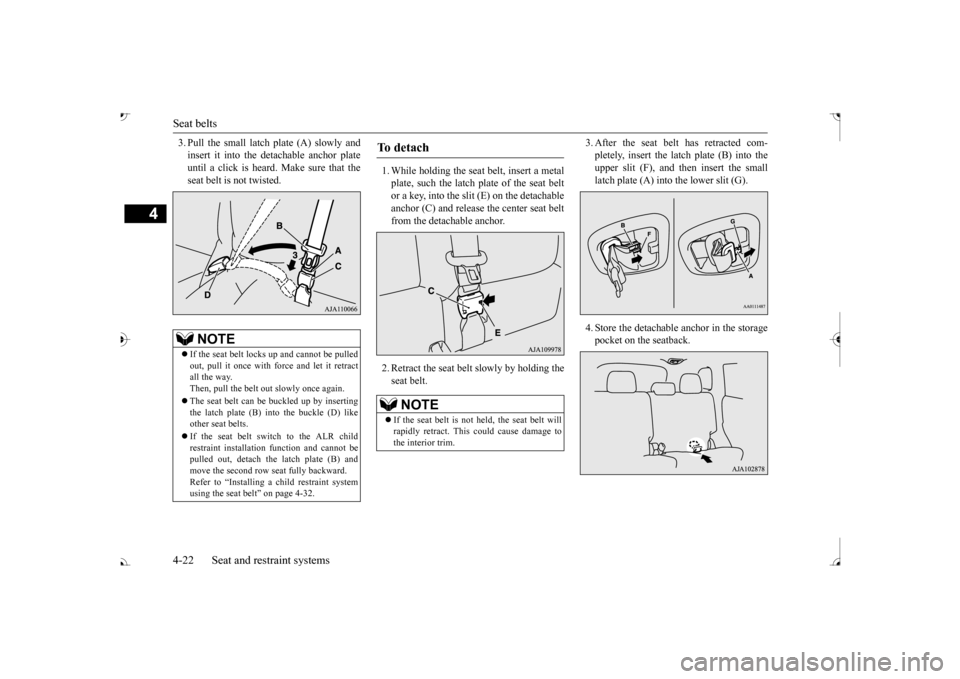
Seat belts 4-22 Seat and restraint systems
4
3. Pull the small latch plate (A) slowly and insert it into the detachable anchor plateuntil a click is heard. Make sure that the seat belt is not twisted.
1. While holding the seat belt, insert a metal plate, such the latch plate of the seat belt or a key, into the slit (E) on the detachable anchor (C) and release the center seat beltfrom the detachable anchor. 2. Retract the seat belt slowly by holding the seat belt.
3. After the seat belt has retracted com- pletely, insert the latch plate (B) into theupper slit (F), and then insert the small latch plate (A) into the lower slit (G). 4. Store the detachable anchor in the storage pocket on the seatback.
NOTE
If the seat belt locks
up and cannot be pulled
out, pull it once with force and let it retract all the way.Then, pull the belt out
slowly once again.
The seat belt can be
buckled up by inserting
the latch plate (B) in
to the buckle (D) like
other seat belts. If the seat belt switch to the ALR child restraint installation
function and cannot be
pulled out, detach the
latch plate (B) and
move the second row seat fully backward. Refer to “Installing a child restraint system using the seat be
lt” on page 4-32.
To d e t a c h
NOTE
If the seat belt is not held, the seat belt will rapidly retract. This
could cause damage to
the interior trim.
BK0239700US.book 22 ページ 2016年6月16日 木曜日 午前10時58分
Page 52 of 521
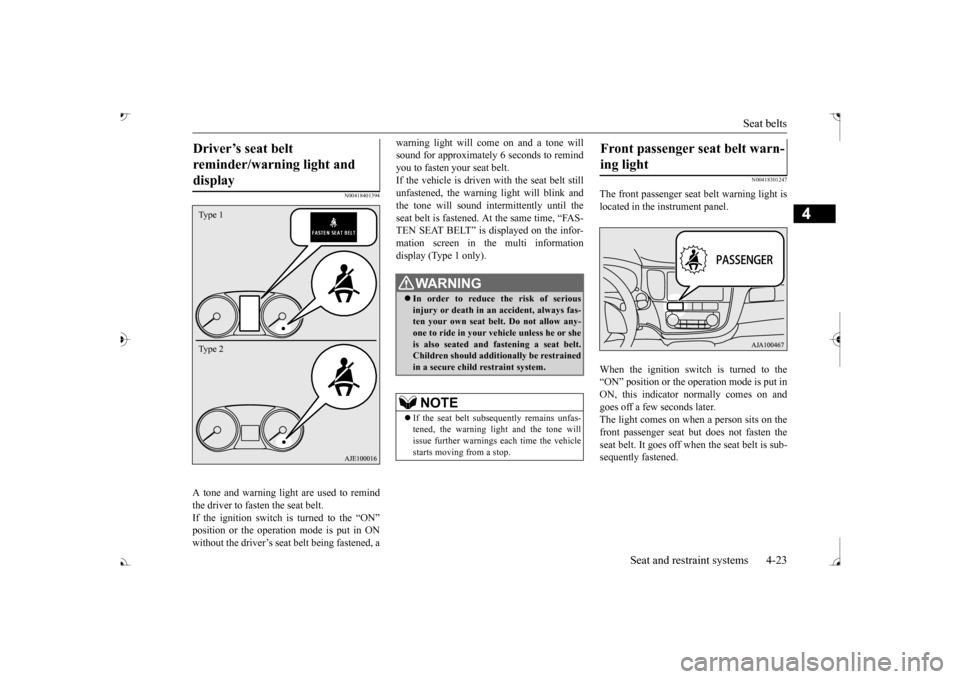
Seat belts
Seat and restraint systems 4-23
4
N00418401394
A tone and warning light are used to remind the driver to fasten the seat belt. If the ignition switch is turned to the “ON”without the driver’s seat belt being fastened, a
warning light will co
me on and a tone will
sound for approximately
6 seconds to remind
you to fasten your seat belt. If the vehicle is driven with the seat belt still unfastened, the warning light will blink andthe tone will sound inte
rmittently until the
seat belt is fastened. At the same time, “FAS- TEN SEAT BELT” is displayed on the infor-mation screen in the multi information display (Type 1 only).
N00418301247
The front passenger seat
belt warning light is
located in the instrument panel. When the ignition switch is turned to the “ON” position or the operation mode is put in ON, this indicator
normally comes on and
goes off a few seconds later.The light comes on when a person sits on the front passenger seat bu
t does not fasten the
seat belt. It goes off when the seat belt is sub-sequently fastened.
Driver’s seat belt reminder/warning light and display Type 1 Type 2
WA R N I N G In order to reduce the risk of serious injury or death in an
accident, always fas-
ten your own seat belt
. Do not allow any-
one to ride in your ve
hicle unless he or she
is also seated and fastening a seat belt. Children should additi
onally be restrained
in a secure child restraint system.NOTE
If the seat belt subse
quently remains unfas-
tened, the warning li
ght and the tone will
issue further warnings
each time the vehicle
starts moving from a stop.
Front passenger seat belt warn- ing light
BK0239700US.book 23 ページ 2016年6月16日 木曜日 午前10時58分
Page 53 of 521
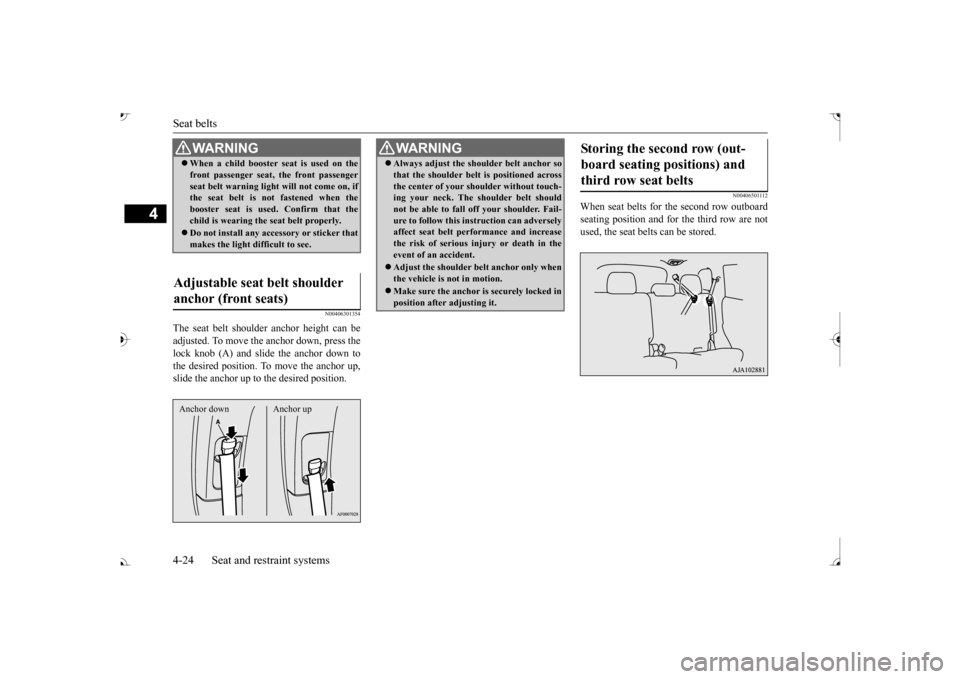
Seat belts 4-24 Seat and restraint systems
4
N00406301354
The seat belt shoulder
anchor height can be
adjusted. To move the anchor down, press thelock knob (A) and slide the anchor down to the desired position. To move the anchor up, slide the anchor up to the desired position.
N00406501112
When seat belts for the second row outboardseating position and for the third row are not used, the seat belts can be stored.
WA R N I N G When a child booster se
at is used on the
front passenger seat, the front passengerseat belt warning ligh
t will not come on, if
the seat belt is not fastened when the booster seat is used
. Confirm that the
child is wearing the
seat belt properly.
Do not install any acce
ssory or sticker that
makes the light difficult to see.
Adjustable seat belt shoulder anchor (front seats) Anchor down Anchor up
WA R N I N G Always adjust the shou
lder belt anchor so
that the shoulder belt
is positioned across
the center of your shoulder without touch-ing your neck. The sh
oulder belt should
not be able to fall off your shoulder. Fail- ure to follow this instruction can adverselyaffect seat belt performance and increase the risk of serious in
jury or death in the
event of an accident. Adjust the shoulder be
lt anchor only when
the vehicle is not in motion. Make sure the anchor is securely locked in position after adjusting it.
Storing the second row (out- board seating positions) and third row seat belts
BK0239700US.book 24 ページ 2016年6月16日 木曜日 午前10時58分
Page 54 of 521
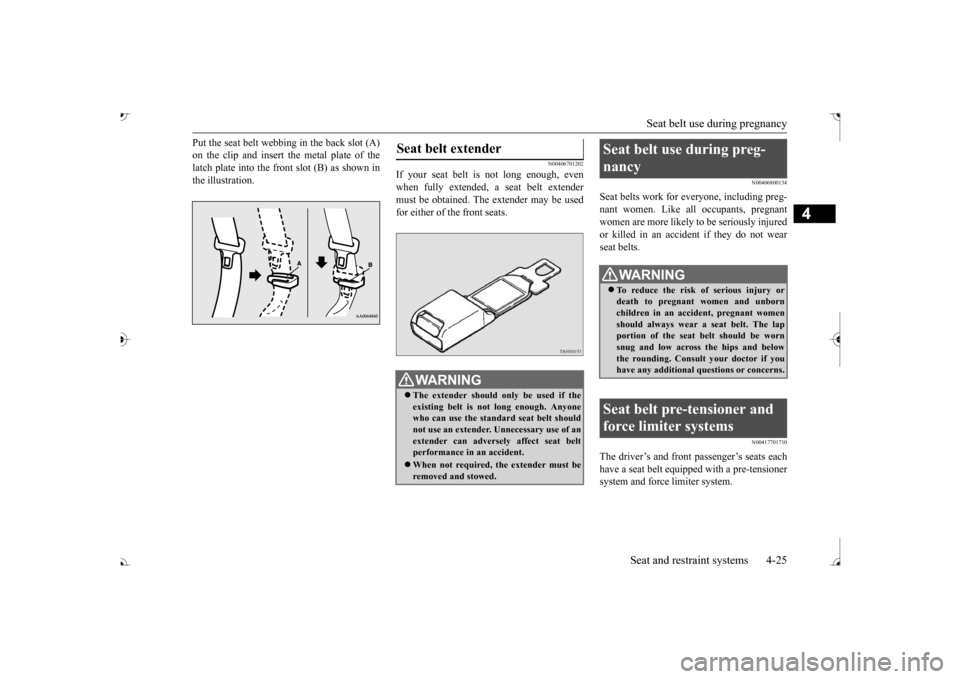
Seat belt use during pregnancy
Seat and restraint systems 4-25
4
Put the seat belt webbing in the back slot (A) on the clip and insert the metal plate of thelatch plate into the front slot (B) as shown in the illustration.
N00406701202
If your seat belt is not long enough, evenwhen fully extended,
a seat belt extender
must be obtained. The extender may be usedfor either of the front seats.
N00406800134
Seat belts work for everyone, including preg- nant women. Like a
ll occupants, pregnant
women are more likely to be seriously injuredor killed in an accident if they do not wear seat belts.
N00417701710
The driver’s and front passenger’s seats each have a seat belt
equipped with a pre-tensioner
system and force limiter system.
Seat belt extender
WA R N I N G The extender should only be used if the existing belt is not long enough. Anyone who can use the standard seat belt shouldnot use an extender. Unnecessary use of an extender can adversel
y affect seat belt
performance in an accident. When not required, the extender must be removed and stowed.
Seat belt use during preg- nancy
WA R N I N G To reduce the risk of serious injury or death to pregnant women and unborn children in an accident, pregnant womenshould always wear
a seat belt. The lap
portion of the seat belt should be worn snug and low across the hips and belowthe rounding. Consult your doctor if you have any additional qu
estions or concerns.
Seat belt pre-tensioner and force limiter systems
BK0239700US.book 25 ページ 2016年6月16日 木曜日 午前10時58分
Page 56 of 521
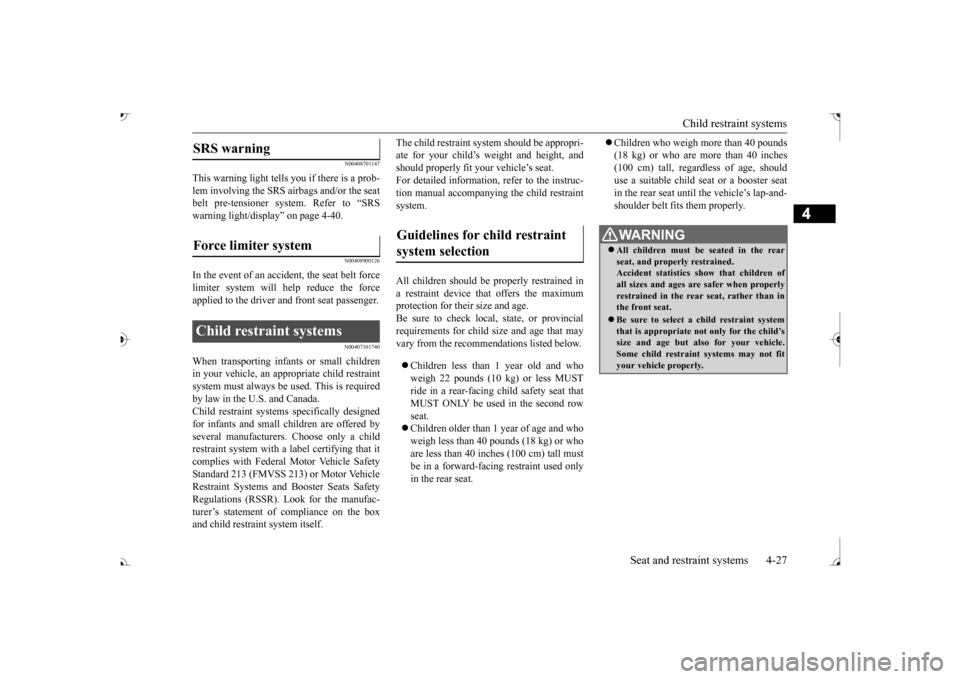
Child restraint systems
Seat and restraint systems 4-27
4
N00408701147
This warning light tells you if there is a prob- lem involving the SRS airbags and/or the seat belt pre-tensioner system. Refer to “SRSwarning light/display” on page 4-40.
N00408900126
In the event of an accident, the seat belt force limiter system will help reduce the force applied to the driver a
nd front seat passenger.
N00407101740
When transporting infants or small children in your vehicle, an appr
opriate child restraint
system must always be
used. This is required
by law in the U.S. and Canada. Child restraint systems specifically designedfor infants and small children are offered by several manufacturers. Choose only a child restraint system with a label certifying that itcomplies with Federal Motor Vehicle Safety Standard 213 (FMVSS 213) or Motor Vehicle Restraint Systems and
Booster Seats Safety
Regulations (RSSR).
Look for the manufac-
turer’s statement of compliance on the box and child restraint system itself.
The child restraint system should be appropri- ate for your child’s we
ight and height, and
should properly fit your vehicle’s seat. For detailed information,
refer to the instruc-
tion manual accompanying the child restraintsystem. All children should be properly restrained in a restraint device that offers the maximumprotection for their size and age. Be sure to check local,
state, or provincial
requirements for child size and age that mayvary from the recommendations listed below. Children less than 1 year old and who weigh 22 pounds (10 kg) or less MUST ride in a rear-facing child safety seat thatMUST ONLY be used in the second row seat. Children older than 1 year of age and who weigh less than 40 pounds (18 kg) or who are less than 40 inches (100 cm) tall must be in a forward-facing restraint used onlyin the rear seat.
Children who weigh more than 40 pounds (18 kg) or who are more than 40 inches(100 cm) tall, regardless of age, should use a suitable child seat or a booster seat in the rear seat until the vehicle’s lap-and-shoulder belt fits
them properly.
SRS warning Force limiter system Child restraint systems
Guidelines for child restraint system selection
WA R N I N G All children must be seated in the rear seat, and properly restrained.Accident statistics
show that children of
all sizes and ages are safer when properly restrained in the rear seat, rather than inthe front seat. Be sure to select a child restraint system that is appropriate not only for the child’s size and age but also for your vehicle. Some child restraint systems may not fityour vehicle properly.
BK0239700US.book 27 ページ 2016年6月16日 木曜日 午前10時58分
Page 57 of 521
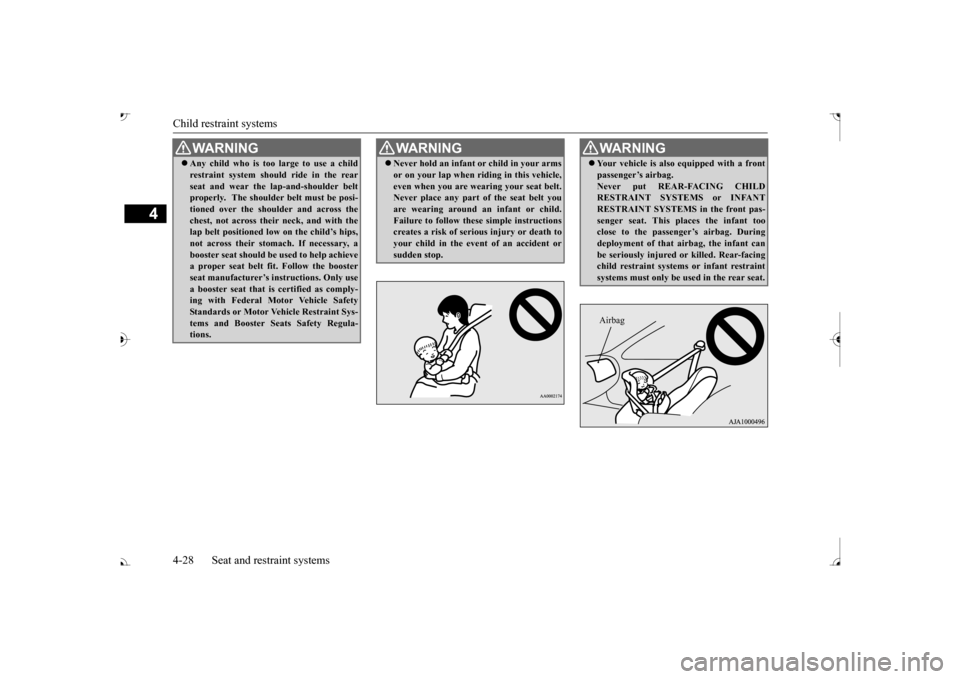
Child restraint systems 4-28 Seat and restraint systems
4
Any child who is too large to use a child restraint system should ride in the rearseat and wear the la
p-and-shoulder belt
properly. The shoulder belt must be posi- tioned over the shou
lder and across the
chest, not across their neck, and with thelap belt positioned low on the child’s hips, not across their stomach. If necessary, a booster seat should be
used to help achieve
a proper seat belt fi
t. Follow the booster
seat manufacturer’s instructions. Only use a booster seat that is
certified as comply-
ing with Federal Motor Vehicle Safety Standards or Motor Vehicle Restraint Sys- tems and Booster Seats Safety Regula-tions. WA R N I N G
WA R N I N G Never hold an infant
or child in your arms
or on your lap when ri
ding in this vehicle,
even when you are wearing your seat belt.Never place any part of the seat belt you are wearing around an
infant or child.
Failure to follow these simple instructionscreates a risk of serious injury or death to your child in the even
t of an accident or
sudden stop.
WA R N I N G Your vehicle is also equipped with a front passenger’s airbag.Never put REAR-FACING CHILDRESTRAINT SYSTEMS or INFANT RESTRAINT SYSTEMS in the front pas- senger seat. This places the infant tooclose to the passenger’s airbag. During deployment of that airbag, the infant can be seriously injured
or killed.
Rear-facing
child restraint systems or infant restraint systems must only be used in the rear seat.Airbag
BK0239700US.book 28 ページ 2016年6月16日 木曜日 午前10時58分
Page 58 of 521

Child restraint systems
Seat and restraint systems 4-29
4
WA R N I N G FRONT-FACING CHILD RESTRAINT SYSTEMS should be used in the rear seatwhenever possible. If one must be used inthe front passenger seat, move the seat to the most rearward po
sition and make sure
the child stays in the child restraint sys-tem, properly restrained. Failure to follow these instructions could result in serious injury or death to the child.WA R N I N G It is important to use an approved rear- facing infant restraint until the infant is one year old (unless
the infant outgrows
the seat sooner). This allows the infant
Page 59 of 521

Child restraint systems 4-30 Seat and restraint systems
4
N00418801167
The outboard seating pos
itions in the second
row seat of your vehicle are equipped with lower anchors for attaching child restraint systems compatible with the LATCH system.
N00418901201
Your vehicle has 3 at
tachment points on the
backside of the second
row seats. These are
for securing a child restraint system tetherstrap to each of the 3 rear seating positions in your vehicle.
N00419000198 N00419101271
1. In order to securely
fasten the tether strap,
remove the head restraint from the loca- tion where you wish to install the child restraint system.2. Open the gap a little between the seat cushion (A) and the seatback (B) with your hand to locate the lower anchors (C).
Installing a child restraint sys- tem using the LATCH (Lower Anchors and Tethers for chil- dren) system Lower anchor locations
NOTE
The symbols on the seatback show the loca- tion of the lower anchor points.
Tether anchor locations
Examples of child restraint sys- tems compatible with the LATCH system A- Rear-facing child restraint system B- Front-facing child restraint system C- Child restraint system lower anchor
connectors
D- Tether strap
(These are only examples.)
Using the LATCH system
BK0239700US.book 30 ページ 2016年6月16日 木曜日 午前10時58分